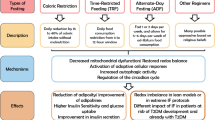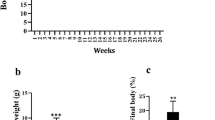Abstract
We investigated the effect of saury oil on the alleviation of metabolic syndrome in mice. Saury oil contains 18% (w/w/) n-3 polyunsaturated fatty acids (n-3 PUFA) and 35% (w/w) monounsaturated fatty acids (MUFA). Diabetic KKAy mice were fed a 10% soybean oil diet (control) or a 10% saury oil diet for 4 weeks, and diet-induced obese C57BL/6J mice were fed a high-fat diet containing 32% lard (control) or 22% lard plus 10% saury oil for 6 weeks. After the intervention periods, the levels of glucose, insulin and lipids in plasma had decreased significantly for the saury oil diet group, and insulin sensitivity had improved. These favorable changes may be attributed to the increased adiponectin and decreased TNFα and resistin levels in plasma. The saury oil diet also resulted in downregulated expression of the lipogenic genes (SREBP-1, SCD-1, FAS, and ACC) as well as upregulation of the fatty acid oxidative gene, CPT-1, and the energy expenditure-related genes (PGC1α and PGC1β) in white adipose tissue for the diet-induced obese C57BL/6J mice. An increase in n-3 PUFA levels and the concomitant decrease in the n-6/n-3 PUFA level ratio in serum, white adipose tissue, and liver with a saury oil diet are likely to be involved in the beneficial changes to the metabolic indicators. MUFA may also play a positive role in remodeling lipid composition. Based on these mice models, our results suggest a potential use for saury oil for improving metabolic abnormalities.



Similar content being viewed by others
Abbreviations
- ACC:
-
Acetyl-CoA carboxylase
- CPT-1:
-
Carnitine palmitoyltransferase-1
- FAS:
-
Fatty acid synthase
- HDL-C:
-
High-density lipoprotein cholesterol
- LDL-C:
-
Low-density lipoprotein cholesterol
- MetS:
-
Metabolic syndrome
- MUFA:
-
Monounsaturated fatty acids
- NEFA:
-
Nonesterified fatty acids
- PGC-1α:
-
Peroxisome proliferator-activated receptor gamma coactivator 1-alpha
- PGC-1β:
-
Peroxisome proliferator-activated receptor gamma coactivator 1-beta
- PUFA:
-
Polyunsaturated fatty acids
- RT-PCR:
-
Reverse transcription polymerase chain reaction
- SAF:
-
Saturated fatty acids
- SCD-1:
-
Stearoyl CoA desaturase-1
- SREBP-1:
-
Sterol regulatory element binding protein-1
- TAG:
-
Triacylglycerol
- TC:
-
Total cholesterol
- WAT:
-
White adipose tissue
References
Gupta A, Gupta V (2010) Metabolic syndrome: what are the risks for humans? Biosci Trends 4:204–212
Phillips C, Lopez-Miranda J, Perez-Jimenez F, McManus R, Roche HM (2006) Genetic and nutrient determinants of the metabolic syndrome. Curr Opin Cardiol 21:185–193
Ruxton CH, Reed SC, Simpson MJ, Millington KJ (2004) The health benefits of omega-3 polyunsaturated fatty acids: a review of the evidence. J Hum Nutr Diet 17:449–459
Perez-Matute P, Perez-Echarri N, Martinez JA, Marti A, Moreno-Aliaga MJ (2007) Eicosapentaenoic acid actions on adiposity and insulin resistance in control and high-fat-fed rats: role of apoptosis, adiponectin and tumour necrosis factor-alpha. Br J Nutr 97:389–398
Mori TA, Bao DQ, Burke V (1999) Dietary fish as a major component of a weight-loss diet: effect on serum lipids, glucose, and insulin metabolism in overweight hypertensive subjects. Am J Clin Nutr 70:817–825
Couet C, Delarue J, Ritz P (1997) Effect of dietary fish oil on body fat mass and basal fat oxidation in healthy adults. Int J Obes 21:637–643
Japan Aquatic Oil Association (ed) (1989) Fatty acid composition of fish and shellfish. Korin Press, Tokyo
Ota T, Takagi T, Kosaka S (1980) Changes in lipids of young and adult saury Cololabis saira (Pisces). Mar Ecol Prog Ser 3:11–17
Pascal JC, Ackman RG (1976) Long-chain monoethylenic alcohol and acid isomers in lipids of copepods and capelin. Chem Phys Lipids 16:219–223
Hardy R, Mackie P (1969) Seasonal variation in some of the lipid components of sprats (Sprattus sprattus). J Sci Food Agric 20:193–198
Ratnayake WN, Ackman RG (1979) Fatty alcohols in capelin, herring and mackerel oils and muscle lipids: I fatty alcohol details linking dietary copepod fat with certain fish depot fats. Lipids 14:795–803
Graeve M, Kattner G (1992) Species-specific differences in intact wax esters of Calanus hyperboreus and C. finmarchicus from Fram Strait-Greenland Sea. Mar Chem 39:269–281
Falk-Petersen S, Sargent JR, Tande KS (1987) Lipid composition of zooplankton in relation to the sub-arctic food web. Polar Biol 8:115–120
Flatmark T, Christiansen EN (1993) Modulation of peroxisomal biogenesis and lipid metabolizing enzymes by dietary factors. In: Gibson G, Lake B (eds) Peroxisomes: biology and importance in toxicology and medicine. Taylor & Francis Ltd, London, pp 247–275
Halvorsen B, Rustan AC, Christiansen EN (1995) Effect of long chain monounsaturated and n-3 polyunsaturated fatty acids on postprandial blood and liver lipids in rats. Scand J Clin Lab Invest 55:469–475
Osterud B, Elvevoll E, Barstad H, Brox J, Halvorsen H, Lia K, Olsen JO, Olsen RO, Sissener C, Rekdal O, Vogild E (1995) Effect of marine oils supplementation on coagulation and cellular activation in whole blood. Lipids 30:1111–1118
Lepage G, Roy CC (1986) Direct transesterification of all classes of lipids in a one-step reaction. J Lipid Res 27:114–120
Stefan N, Stumvoll M (2002) Adiponectin—its role in metabolism and beyond. Horm Metab Res 34:469–474
Kadowaki T, Yamauchi T, Kubota N, Hara K, Ueki K, Tobe K (2006) Adiponectin and adiponectin receptors in insulin resistance, diabetes, and the metabolic syndrome. J Clin Invest 116:1784–1792
Mantzoros CS, Li T, Manson JE, Meigs JB, Hu FB (2005) Circulating adiponectin levels are associated with better glycemic control, more favorable lipid profile, and reduced inflammation in women with type 2 diabetes. J Clin Endocrinol Metab 90:4542–4548
Shulman GI (2000) Cellular mechanisms of insulin resistance. J Clin Invest 106:171–176
Hotamisligil GS (1999) The role of TNF-alpha and TNF receptors in obesity and insulin resistance. J Intern Med 245:621–625
Das UN (1999) GLUT-4, tumor necrosis factor, essential fatty acids and daf-genes and their role in insulin resistance and non-insulin dependent diabetes mellitus. Prostaglandins Leukot Essent Fatty Acids 60:13–20
Savage DB, Sewter CP, Klenk ES, Segal DG, Vidal-Puig A, Considine RV, O’Rahilly S (2001) Resistin/Fizz3 expression in relation to obesity and peroxisome proliferator-activated receptor-gamma action in humans. Diabetes 50:2199–2202
Norata GD, Ongari M, Garlaschelli K, Raselli S, Grigore L, Catapano AL (2007) Plasma resistin levels correlate with determinants of the metabolic syndrome. Eur J Endocrinol 156:279–284
Munzberg H (2009) Leptin-signaling pathways and leptin resistance. Forum Nutr 63:123–132
Guerre-Millo M (2002) Adipose tissue hormones. J Endocrinol Invest 25:855–861
Saraswathi V, Gao L, Morrow JD, Chait A, Niswender KD, Hasty AH (2007) Fish oil increases cholesterol storage in white adipose tissue with concomitant decreases in inflammation, hepatic steatosis, and atherosclerosis in mice. J Nutr 137:1776–1782
Itoh M, Suganami T, Satoh N, Tanimoto-Koyama K, Yuan X, Tanaka M, Kawano H, Yano T, Aoe S, Takeya M, Shimatsu A, Kuzuya H, Kamei Y, Ogawa Y (2007) Increased adiponectin secretion by highly purified eicosapentaenoic acid in rodent models of obesity and human obese subjects. Arterioscler Thromb Vasc Biol 27:1918–1925
Krebs JD, Browning LM, McLean NK, Rothwell JL, Mishra GD, Moore CS, Jebb SA (2006) Additive benefits of long-chain n-3 polyunsaturated fatty acids and weight-loss in the management of cardiovascular disease risk in overweight hyperinsulinaemic women. Int J Obesity 30:1535–1544
Das UN (2005) A defect in the activity of ∆5 and ∆6 desaturases may be a factor in pre-disposing to the development of insulin resistance syndrome. Prostaglandins Leukot Essent Fatty Acids 72:343–350
Drevon CA (2005) Fatty acids and the expression of adipokines. Biochim Biophys Acta 1740:287–292
Reseland JE, Anderssen SA, Solvoll K, Hjermann I, Urdal P, Holme I, Drevon CA (2001) Effect of long-term changes in diet and exercise on plasma leptin concentrations. Am J Clin Nutr 73:240–245
Shimano H, Shimomura I, Hammer RE, Herz J, Goldstein JL, Brown MS, Horton JD (1997) Elevated levels of SREBP-2 and cholesterol synthesis in livers of mice homozygous for a targeted disruption of the SREBP-1 gene. J Clin Invest 100:2115–2124
Nakatani T, Kim HJ, Kaburagi Y, Yasuda K, Ezaki O (2003) A low fish oil inhibits SREBP-1 proteolytic cascade, while a high-fish-oil feeding decreases SREBP-1 mRNA in mice liver: relationship to anti-obesity. J Lipid Res 44:369–379
Howell G 3rd, Deng X, Yellaturu C, Park EA, Wilcox HG, Raghow R, Elam MB (2009) N-3 polyunsaturated fatty acids suppress insulin-induced SREBP-1c transcription via reduced trans-activating capacity of LXRalpha. Biochim Biophys Acta 1791:1190–1196
McGarry JD, Brown NF (1997) The mitochondrial carnitine palmitoyltransferase system. From concept to molecular analysis. Eur J Biochem 244:1–14
Wu Z, Puigserver P, Andersson U, Zhang C, Adelmant G, Mootha V, Troy A, Cinti S, Lowell B, Scarpulla RC, Spiegelman BM (1999) Mechanisms controlling mitochondrial biogenesis and respiration through the thermogenic coactivator PGC-1. Cell 98:115–124
Puigserver P, Spiegelman BM (2003) Peroxisome proliferator-activated receptor-gamma coactivator 1 alpha (PGC-1 alpha): transcriptional coactivator and metabolic regulator. Endocr Rev 24:78–90
Uldry M, Yang W, St-Pierre J, Lin J, Seale P, Spiegelman BM (2006) Complementary action of the PGC-1 coactivators in mitochondrial biogenesis and brown fat differentiation. Cell Metab 3:333–341
Flachs P, Horakova O, Brauner P, Rossmeisl M, Pecina P, Franssen-van Hal N, Ruzickova J, Sponarova J, Drahota Z, Vlcek C, Keijer J, Houstek J, Kopecky J (2005) Polyunsaturated fatty acids of marine origin upregulate mitochondrial biogenesis and induce beta-oxidation in white fat. Diabetologia 48:2365–2375
Whelan J (1996) Antagonistic effects of dietary arachidonic acid and n-3 polyunsaturated fatty acids. J Nutr 126:1086S–1091S
Simopoulos AP (2002) The importance of the ratio of omega-6/omega-3 essential fatty acids. Biomed Pharmacother 56:365–379
Hibbeln JR, Nieminen LR, Blasbalg TL, Riggs JA, Lands WE (2006) Healthy intakes of n-3 and n-6 fatty acids: estimations considering worldwide diversity. Am J Clin Nutr 83:1483S–1493S
Smith BK, Holloway GP, Reza-Lopez S, Jeram SM, Kang JX, Ma DW (2010) A decreased n-6/n-3 ratio in the fat-1 mouse is associated with improved glucose tolerance. Appl Physiol Nutr Metab 35:699–706
Kris-Etherton P, Daniels SR, Eckel RH, Engler M, Howard BV, Krauss RM (2001) AHA scientific statement: summary of the Scientific Conference on Dietary Fatty Acids and Cardiovascular Health. Conference summary from the Nutrition Committee of the American Heart Association. J Nutr 131:1322–1326
Moon JH, Lee JY, Kang SB, Park JS, Lee BW, Kang ES, Ahn CW, Lee HC, Cha BS (2010) Dietary monounsaturated fatty acids but not saturated fatty acids preserve the insulin signaling pathway via IRS-1/PI3 K in rat skeletal muscle. Lipids 45:1109–1116
Acknowledgments
The authors gratefully acknowledge the technical assistance of Dr. Toru Moriguchi (Azabu University), Ms. Akiko Harauma, Mr. Nobushige Doisaki and Ms. Kiyomi Furihata in Nippon Suisan Kaisya, Ltd.
Author information
Authors and Affiliations
Corresponding author
About this article
Cite this article
Yang, ZH., Miyahara, H., Takemura, S. et al. Dietary Saury Oil Reduces Hyperglycemia and Hyperlipidemia in Diabetic KKAy Mice and in Diet-Induced Obese C57BL/6J Mice by Altering Gene Expression. Lipids 46, 425–434 (2011). https://doi.org/10.1007/s11745-011-3553-1
Received:
Accepted:
Published:
Issue Date:
DOI: https://doi.org/10.1007/s11745-011-3553-1




